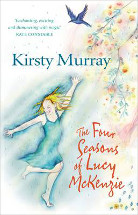The four seasons of Lucy McKenzie by Kirsty Murray

Allen and Unwin, 2013. ISBN 9781743317020.
(Age: (9-12) Highly recommended. When her sister falls ill and her
mother has to go to Paris, Lucy McKenzie is sent to the country to
stay with her Great Aunt Big, who lives in Avendale, an old house in
a hidden valley. She is very unhappy about being there but then she
discovers that the old house is full of mysteries. One night she
hears a voice calling from inside a painting on the wall and
entering the scene becomes friends with three children on the other
side of the painting. There she has many adventures, fighting a
bushfire, battling a flood and riding horses through the bush. But
why has Lucy been taken to the 1930's and why does she need to
befriend April, Tom and Jimmy Tiger?
This is a very engaging time-slip novel, bringing to life what it
was like to live in the country in the 1930's and contrasting it
with life today. Murray keeps up the suspense about what is
happening and who the children are as Lucy gradually becomes friends
with them and learns that she has abilities to help in times of
danger. It is the knowledge that Lucy brings from the 21st century
that helps to put out a bushfire and save the family's house. The
mystery surrounding the children is beautifully realised as Lucy
begins to grow and mature.
Murray also subtly looks at the role of women in the 1930's. As Lucy
gradually begins to appreciate her aunt's eccentric personality and
stops hating being at Avendale, she finds Big has had to sacrifice
her own career to look after father. However she is not a bitter
person, but one who appreciates the beauty of the countryside and
her paintings of it. Lucy discovers from her friendship with Lucy
that regardless of age, you are still the same person inside.
Lucy also has to think about what would happen if she changed the
future through her actions in the past. Even though she tries to
warn Tom not to go to war she realises the consequences of her
actions.
True to life characters, a beautiful bush setting, and a look at
life in the 1930s make this a fascinating and worthwhile read.
Pat Pledger